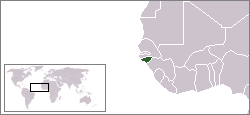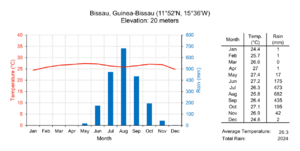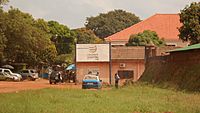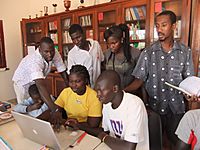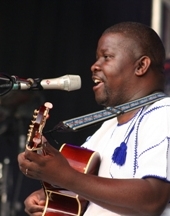Guinea-Bissau facts for kids
Quick facts for kids
Republic of Guinea-Bissau
|
|
|---|---|
|
Motto:
Unidade, Luta, Progresso "Unity, Struggle, Progress" |
|
|
Anthem:
Esta É a Nossa Pátria Bem Amada "This is Our Beloved Homeland" |
|
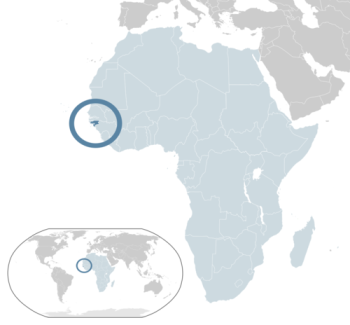
Location of Guinea-Bissau (dark blue) in the African Union (light blue)
|
|
| Capital and largest city
|
Bissau 11°52′N 15°36′W / 11.867°N 15.600°W |
| Official languages | Portuguese |
| Spoken languages |
List:
Guinea-Bissau Creole
English French Arabic Balanta Hassaniya Jola-Fonyi Mandinka Manjak Mankanya Noon Portuguese Pulaar Serer Soninke |
| Ethnic groups
(2019)
|
|
| Religion
(2020)
|
|
| Demonym(s) | Bissau-Guinean Guinean |
| Government | Unitary semi-presidential republic |
| Umaro Sissoco Embaló | |
| Rui Duarte de Barros | |
| Legislature | National People's Assembly |
| Independence from Portugal | |
|
• Declared
|
24 September 1973 |
|
• Recognized
|
10 September 1974 |
| Area | |
|
• Total
|
36,125 km2 (13,948 sq mi) (134th) |
|
• Water (%)
|
22.4 |
| Population | |
|
• 2023 estimate
|
2,078,820 (150th) |
|
• Density
|
46.9/km2 (121.5/sq mi) (154th) |
| GDP (PPP) | 2023 estimate |
|
• Total
|
|
|
• Per capita
|
|
| GDP (nominal) | 2023 estimate |
|
• Total
|
|
|
• Per capita
|
|
| Gini (2021) | ▼ 33.4 medium |
| HDI (2022) | low · 179th |
| Currency | West African CFA franc (XOF) |
| Time zone | UTC (GMT) |
| Driving side | right |
| Calling code | +245 |
| ISO 3166 code | GW |
| Internet TLD | .gw |
Guinea-Bissau (ghin-EE-_-BISS-ow; Portuguese: Guiné-Bissau), officially called the Republic of Guinea-Bissau, is a country in West Africa. It covers about 36,125 square kilometres (13,948 sq mi) (13,948 sq mi) and has around 2 million people. The country shares borders with Senegal to the north and Guinea to the southeast.
Guinea-Bissau was once part of the Kaabu kingdom and the Mali Empire. Later, parts of it came under the rule of the Portuguese Empire starting in the 1500s. In the 1800s, it became a Portuguese colony called Portuguese Guinea. Portugal gained full control of the mainland by 1915 and the Bissagos Islands by 1936.
The country declared its independence in 1973, which was recognized in 1974. The capital city, Bissau, was added to the country's name to avoid confusion with the neighboring country, Guinea. Since gaining independence, Guinea-Bissau has faced political challenges.
While Portuguese is the official language, only a small number of people speak it as their first language. Most people speak Guinea-Bissau Creole, which is a mix of Portuguese and African languages. It is considered the national language and helps different groups communicate. Many people in Guinea-Bissau follow Islam, Christianity, or traditional African faiths. The country's economy is one of the smallest in the world.
Guinea-Bissau is a member of many international groups. These include the United Nations, the African Union, and the Community of Portuguese Language Countries.
Contents
Geography of Guinea-Bissau
Guinea-Bissau is located on the west coast of Africa. It has Senegal to its north and Guinea to its south and east. The Atlantic Ocean is to its west. The country is mostly flat, with low coastal plains and swamps. Further inland, the land rises to a mix of forests and savannas.
The weather is warm all year. It has a rainy season from June to October and a dry season from December to April. The Bijagos Archipelago, a group of islands, is located off the coast.
Environmental Challenges
Guinea-Bissau faces serious environmental issues. These include cutting down too many trees (deforestation) and soil wearing away (soil erosion). There is also too much grazing by animals and too much overfishing. These problems affect the country's natural environment.
Wildlife
Guinea-Bissau is home to various types of wildlife.
Economy and Trade
Guinea-Bissau has one of the lowest economies in the world. More than two-thirds of its people live in poverty. The economy mostly relies on farming. Its main exports are fish, cashew nuts, and groundnuts.
The country has had a long period of political problems. This has slowed down its economy and made social conditions difficult. It also takes a very long time to start a new business in Guinea-Bissau.
Recently, the country has started to see some economic improvements. This is thanks to a stability agreement signed by its main political parties.
Regions and Local Areas
Guinea-Bissau is divided into 8 regions and one special area called an autonomous sector. These are then split into 37 smaller areas. The regions are:
Languages Spoken
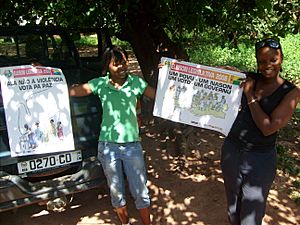
Even though Guinea-Bissau is a small country, it has many different ethnic groups. Each group has its own culture and language. This is because many people have moved to or through Guinea-Bissau over time. The arrival of the Portuguese also brought the Portuguese language and a mixed language called Kriol.
Standard Portuguese is the official language. However, most people speak it as a second language, and only a few speak it as their first language. It is mainly used by government officials and educated people. Schooling is in Portuguese, but not all children have access to formal education.
Kriol is spoken by almost half the population as a first language. It is the most common language for communication between different groups. Most people in the country understand Kriol.
People in rural areas also speak many native African languages. These include Fula, Balanta, and Mandinka. These languages are important for connecting people of the same ethnic background. They are used daily in villages and for traditional ceremonies.
French is taught in schools because Guinea-Bissau is surrounded by French-speaking countries. Guinea-Bissau is also a member of the Francophonie, a group of French-speaking nations.
Religions in Guinea-Bissau
| Religion in Guinea-Bissau (CIA, 2020 est.) | ||||
|---|---|---|---|---|
| Religion | Percent | |||
| Islam | 46.1% | |||
| Folk religions | 30.6% | |||
| Christianity | 18.9% | |||
| Other/unaffiliated | 4.4% | |||
About half of the people in Guinea-Bissau are Muslim. Many others follow folk religions or Christianity. Some people combine their religious practices with traditional African beliefs.
Muslims are more common in the north and east of the country. Christians are more common in the south and along the coast. The Roman Catholic Church is the largest Christian group.
Leaders of different religious groups believe that people in Guinea-Bissau are generally tolerant of each other's beliefs.
Climate
Guinea-Bissau is warm all year, with average temperatures around 26.3 °C (79.3 °F). The capital, Bissau, gets about 2,024 millimetres (79.7 in) of rain each year. Most of this rain falls during the rainy season, from June to September or October. From December to April, the country experiences dry weather.
Education System
Education is required for children aged 7 to 13. There are five levels of education: pre-school, basic, secondary, technical, and higher education. Basic education now lasts for six years. Secondary education is widely available and has two cycles.
Higher education, like university, is limited in Guinea-Bissau. Many students choose to study abroad, often in Portugal. There are some universities in the country, including a Faculty of Law and a Faculty of Medicine.
Unfortunately, child labor is common. More boys attend school than girls. In 2011, about 55.3% of the population could read and write. This included 68.9% of males and 42.1% of females.
Culture
Music
The music of Guinea-Bissau is often linked to the polyrhythmic gumbe style. This is the country's main musical export. Gumbe music combines about ten of the country's traditional folk music styles.
The cabasa is a very important musical instrument in Guinea-Bissau. It is used in fast and complex dance music. Songs are almost always in Guinea-Bissau Creole and are often funny or about current events.
Other popular music styles include Tina and Tinga. Traditional folk music is used for funerals, initiations, and other ceremonies. Different ethnic groups also have their own unique sounds, like Balanta brosca and kussundé, Mandinga djambadon, and the kundere sound from the Bissagos Islands.
Cuisine
Common dishes in Guinea-Bissau include soups and stews. Popular ingredients are yams, sweet potato, cassava, onion, tomato, and plantain. Spices, peppers, and chilies are often used, including Aframomum melegueta seeds, also known as Guinea pepper.
Film
Flora Gomes is a famous film director from Guinea-Bissau. His most well-known film is Nha Fala, which means "My Voice." Gomes's Mortu Nega (Death Denied) was the first fiction film made in Guinea-Bissau in 1988. Another film, Udju Azul di Yonta, was shown at the 1992 Cannes Film Festival. Gomes has also been a part of many film festivals focused on African cinema. The actress Babetida Sadjo was born in Bafatá, Guinea-Bissau.
Sports
Football is the most popular sport in Guinea-Bissau. The Guinea-Bissau national football team is managed by the Football Federation of Guinea-Bissau. They are members of the Confederation of African Football (CAF) and FIFA.
Images for kids
-
Bridge in São Vicente, Cacheu
-
Rare salt water Hippopotamuses in Orango Island
See also
 In Spanish: Guinea-Bisáu para niños
In Spanish: Guinea-Bisáu para niños




